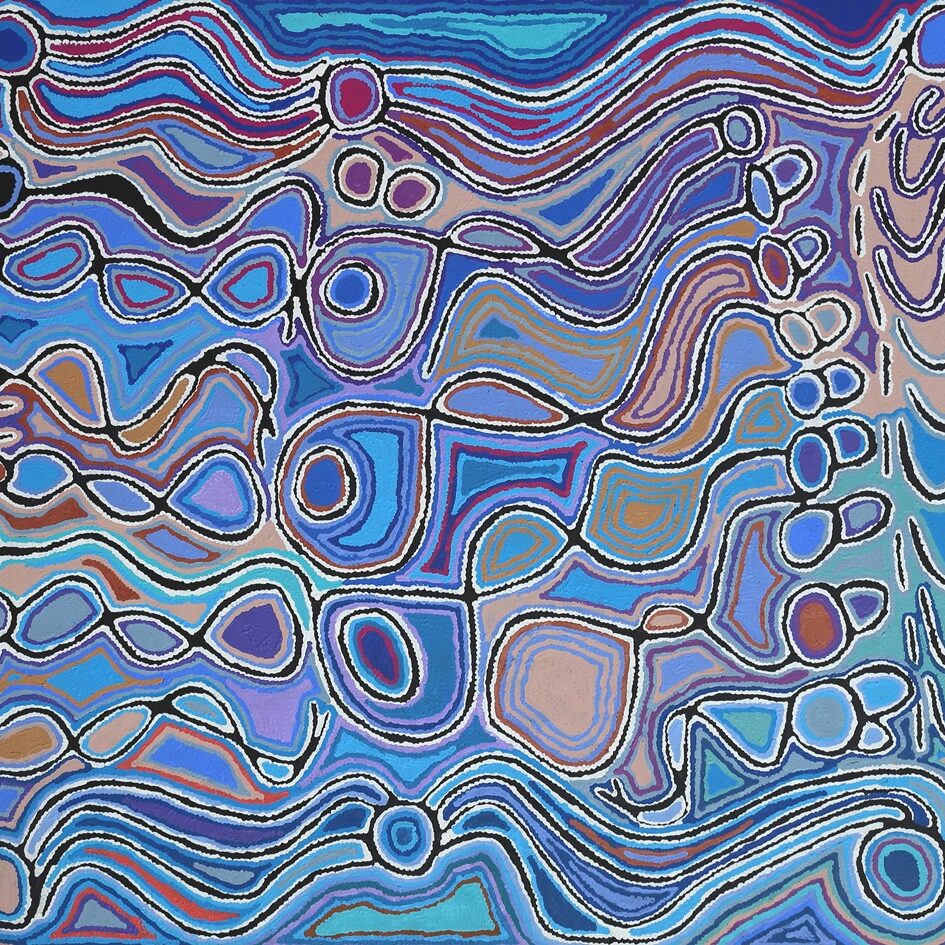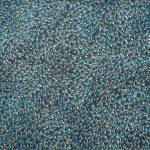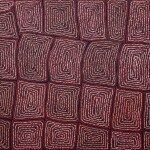Australian Aboriginal Dot Painting
Early Origins of Aboriginal Dot Painting Styles
Aboriginal peoples have used dots in art and other forms of expression for a very long time. Dots can be seen in symbolic patterns carved on artefacts and ancient rock galleries. They were used in sand paintings and in body painting for ceremonies.
The original use of the dot painting style may have been to create a ‘shimmer’ effect on a body design or in the decoration of an artefact. The dots might suggest an energy field or powerful aura around the design.
In more recent times, the distinctive dot painting style of Aboriginal artists emerged in the early 1970s from Papunya Tula artists. Dot painting styles are often seen in art works from the Central and Western Desert regions in Australia.

Dot Painting Techniques Used at Papunya
Papunya is an Indigenous Australia community about two hours drive to the north-west of Alice Springs, in the centre of Australia.
In early developments at Papunya in the 1970s, the dot painting technique started to be used by artists.
Dots were used to in-fill designs.
Dots were also useful to obscure certain information and associations that lay underneath the dotting.
At this time, the Aboriginal artists were negotiating what aspects of stories were secret or sacred, and what aspect were in the public domain.
The dot painting technique gave some protection, allowing some elements of stories that should not be seen by the uninitiated to remain concealed.
Dot Painting and Desert Aboriginal Art
The dot painting style became the recognisable characteristic of desert Aboriginal art by the 1980s. The movement spread steadily to reach a range of the desert communities.
Papunya, Kintore, Yuendumu, Mt Liebig, Haasts Bluff, Utopia, Balgo, Kiwirrkura and many smaller communities and outstations evolved variations in the way they went about painting and story-telling.
The language groups involved included artists from Pintupi, Luritja, Arrente, Warlpiri, Alyawarr, Anmatyerr, and other Central Desert language groups.
Pintupi and Utopia Artists and Dot Painting
Pintupi artists from the Western desert tended to first lay out their designs using ancient iconography. They then built the fields of dots emanating from the design structure.
Later artists started to include dotting that merged together into a ‘dot and drag’ style, where linear works are created with the dots joined together in extended lines.
Utopia artists from the Central desert evolved a very finely detailed and articulated method of dotting, creating subtle motifs and patterns that existed within a grander space created by the dotting.
Famous Artists With Dot Painting Styles
Some of Australia's most famous Aboriginal artists are, or have been, associated with dot painting styles.
Emily Kame Kngwarreye is Australia's most successful female artist by sales. Creation - one of her large dot paintings - sold for $2.1 million dollars. Clifford Possum Tjapaltjarri is perhaps the most famous male Australian Aboriginal artist and his dot art style is very well known - his daughters Gabriella Possum Nungurrayi and Michelle Possum Nungurrayi continue to explore using dot painting techniques today.
Some of the many other famous Aboriginal artists who used dot art styles include Rover Thomas, Bill Whiskey Tjapaltjarri, Dorothy Napangardi, Tommy Watson and George Ward Tjungurrayi.
Adaptations of Dot Art
Australian Indigenous artists developed their own approaches to dot painting and some have since adapted the technique to become more like a dabbing process, with whole areas filled in by adjoining dots to create a dense field of colour. Sometimes this was dotted over again in contrasting colours.
The tradition of painting with a dotting technique has transformed the way Aboriginal groups have presented themselves and their culture to the outside world.
The modern process is measured in just over forty years of art production, but the diversity and personal creations have ensured that the tradition continues to reinvigorate itself and its creators.
Did Dot Artworks First Start Appearing in the 1970s?
At Japinkga Gallery we are sometimes asked our opinion about when people started to see dot painting. There’s a curiosity about whether we would have seen this type of patterning and dot work in artworks prior to the 1970’s.
The short answer is probably no, people wouldn't have had access to seeing anything like it.
For a start, it would be a very rare thing to see an Aboriginal symbol or depiction shown anywhere. There was some knowledge of the bark painting coming out of the Northern Territory. People knew of the bark painting styles, like the crosshatching and the x-ray designs from Arnhem Land. They were in museums and art galleries and people also knew Albert Namatjira landscapes of Central Australia.
There were also anthropologists collecting artefacts or very sacred items, perhaps a stone tjuringa that had designs on it. Those items may have had dot embellishments on them. However the chances of someone in the broader community seeing something like dot painting would have been very slim.
Mostly there were many various Aboriginal cultures across Australia whose identities were totally not understood or not seen by anyone outside their own community.
We started seeing dot painting in art galleries in Perth after the mid 1970s. The Central Desert art movement had begun to get going and there were collections of works being shown in the Art Gallery of Western Australia. I think the first time I ever saw a dot painting was around 1975 or 1976.
There might have been some in publications, but pre-1970, you just wouldn’t have seen very much of it anywhere.
Now if you ask an everyday person in the street how would they describe an Aboriginal artwork, a typical response would likely be a description of dot painting. If you ask a child to do an Aboriginal style artwork they'll start dot painting. Those aesthetic qualities have captured people's beliefs and understandings of what Aboriginal art is.
This Central Desert style has created the contemporary movement in Aboriginal art. It's captured the impetus, it's reached every part of Australian society. Therefore I think it is recognised as the prototype Aboriginal style.
You can probably show this work to anyone with a bit of artistic exposure and interest and they'll probably be able to recognise this, whether they're Australian or not. That's how deep it has gone in terms of recognising dot painting as belonging to a particular cultural group; it's quite extraordinary.
The desert area is enormous, it's getting up towards two thirds of the inland part of Australia, and the culture is shared, and the dot painting style belongs right across that region. So it is true that many think of this as what Aboriginal painting is.
Some Aboriginal painters who are not in that genre say, "Actually, we've been swamped. We've been swamped by the success of dot painting and it's really hard for us to make our mark from under the shadow of this huge movement that's had so much success."
So in a relatively short period of time a style has come to dominate what is thought of as Aboriginal art. It is good to reflect that just as there is great diversity within indigenous communities there is also great diversity in the style of art that is being produced by those communities.
If you scroll down the Japingka Artists page you’ll see instantly that contemporary Aboriginal art is dot painting and so very much more. Many of the indigenous artists at work in Australia today are extremely innovative.
It is still a joy to see exhibitions of dot painting coming in that take your breath away. It is also a joy to see new styles emerging that take traditions and build on them in exciting new ways.
I believe there is still so much life and possibility to this intriguing art movement. Even now, thirty years down the track for us, we are all still excited and curious when the new works come in. Whatever the style of paintings we see passion, commitment and a universal language that speaks for itself.












